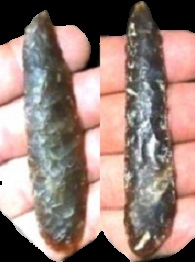Name Details:
Named By:
Gregory Perino
Named For:
Plains Culture
Date Identified:
2002
Type Site:
Plains (Late) Knife
Cluster:
Commonly Utilized Material:
A variety of locally available materials commonly heat
treated.
Date:
Cultural Period:
Glacial Period:
Culture:
700 - 200 B.P.
Developmental
Medieval Warm
Outline is Representative of Common Size and Shape:
Description of Physical Characteristics and Flaking Pattern:
This is a medium (2.5 to 3.5 inch) ovoid
knife with an elliptical cross section. The blade is slender
and excurvate with an asymmetrical blade. The base is convex
with rounded basal corners. This knife has a random flaking
pattern.
Size Measurements -
Data Needed
Distribution:
Distribution Comments:
This point is associated with nomadic bison hunters of the plains and prairie region. This point is found from the plains of Saskatchewan and Alberta into the Plains of
Montana, North and South Dakota. May be found into the plains region of Colorado, Nebraska and into Kansas.
The highest concentrations of these points are found in the southern
region of the plains suggesting a Mississippian cultural influence (Drager
and Ireland (1986)

Additional Comments:
Loyd Doty writes:
(LATE) PLAINS KNIFE – was proposed by Greg Perino in the last revision of his typology reference
guide. They are medium sized
(2.5” to 3.5”) long, slender socketed knives with slightly round tips,
irregular blade edges and round bases. Both blade edges exhibit rework but there is no beveling. Examples shown are nearly exhausted. Reference: Perino, Gregory 1991 (2002 revised edition), Selected Preforms, Points and Knives
of the North American Indians. Vols. 1, 2, 3, & 4. Points and Barbs
Press, 1509 Cleveland, Idabel, Oklahoma 74745.
Pictures:

Pictures Provided By:
Loyd Doty
References: (See Reference Page, Entry Number):
92
Other points in this Cluster:
Point Validity: Collector Type
Perino was a well-respected
self-taught archeologist who was the founder of the Illinois State Archeological Society. This point was named in a professional publication, but has no professional
references. This type has many collector source references. This is considered a collector type.
Age Details:
Plains Knife, Late Plains Knife



